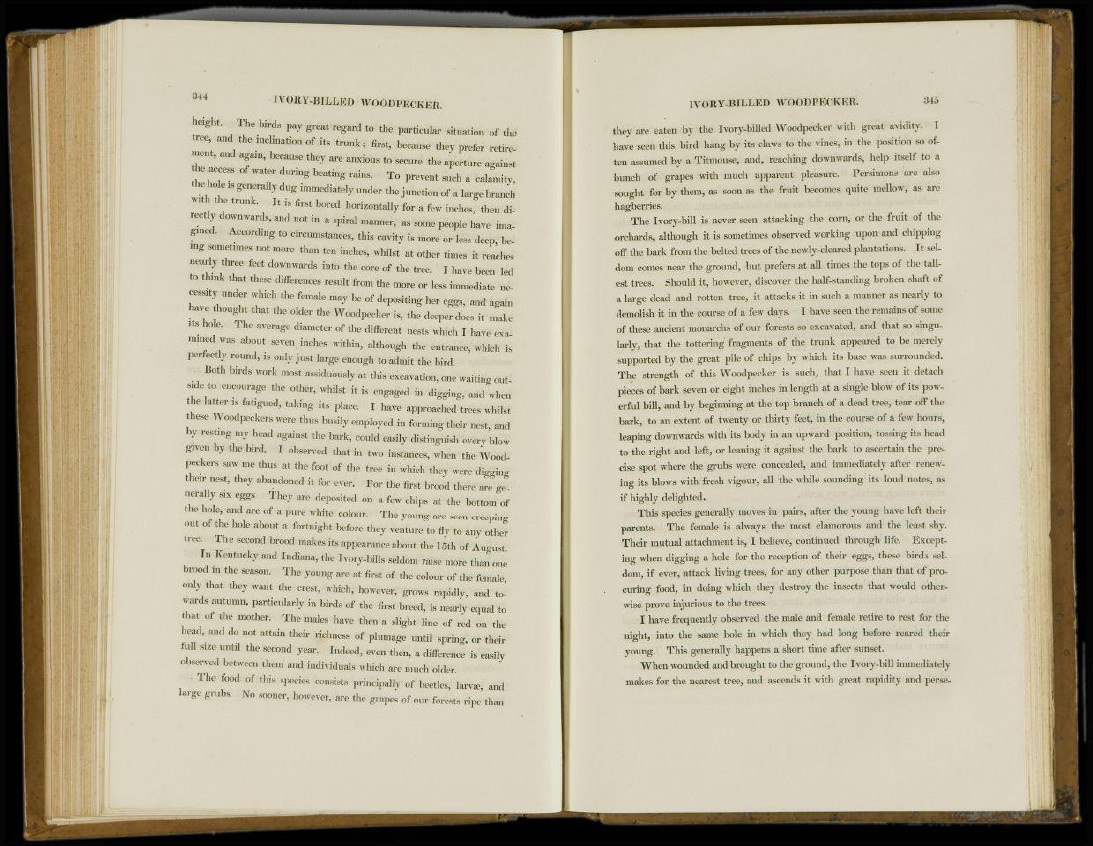
height. The birds pay great regard to the particular situation of the
tree, and the inclination of its trunk; first, because they prefer retirement,
and again, because they are anxious to secure the aperture against
the access of water during beating rains. To prevent such a calamity,
the hole is generally dug immediately under the junction of a large branch
with the trunk. It is first bored horizontally for a few inches, then directly
downwards, and not in a spiral manner, as some people have imagined.
According to circumstances, this cavity is more or less deep, being
sometimes not more than ten inches, whilst at other times it reaches
nearly three feet downwards into the core of the tree. I have been led
to think that these differences result from the more or less immediate necessity
under which the female may be of depositing her eggs, and again
have thought that the older the Woodpecker is, the deeper does it make
its hole. The average diameter of the different nests which I have examined
was about seven inches within, although the entrance, which is
perfectly round, is only just large enough to admit the bird.
Both birds work most assiduously at this excavation, one waiting outside
to encourage the other, whilst it is engaged in digging, and when
the latter is fatigued, taking its place. I have approached trees whilst
these Woodpeckers were thus busily employed in forming their nest, and
by resting my head against the bark, could easily distinguish every blow
given by the bird. I observed that in two instances, when the Woodpeckers
saw me thus at the foot of the tree in which they were digging
their nest, they abandoned it for ever. For the first brood there are ge
nerally six eggs They are deposited on a few chips at the bottom of
the hole, and are of a pure white colour. The young are seen creeping
out of the hole about a fortnight before they venture to fly to any other
tree. The second brood makes its appearance about the 15th of August.
In Kentucky and Indiana, the Ivory-bills seldom raise more than one
brood in the season. The young are at first of the colour of the female,
only that they want the crest, which, however, grows rapidly, and towards
autumn, particularly in birds of the first breed, is nearly equal to
that of the mother. The males have then a slight line of red on the
head, and do not attain their richness of plumage until spring, or their
full size until the second year. Indeed, even then, a difference is easily
observed between them and individuals which are much older.
The food of this species consists principally of beetles, larva?, and
large grubs, No sooner, however, are the grapes of our forests ripe than
thev are eaten by the Ivory-billed Woodpecker with great avidity. I
have seen this bird hang by its claws to the vines, in the position so often
assumed by a Titmouse, and, reaching downwards, help itself to a
bunch of grapes with much apparent pleasure. Persimons are also
sought for by them, as soon as the fruit becomes quite mellow, as are
hagberries.
The Ivory-bill is never seen attacking the corn, or the fruit of the
orchards, although it is sometimes observed working upon and chipping
off the bark from the belted trees of the newly-cleared plantations. It seldom
comes near the ground, but prefers at all times the tops of the tallest
trees. Should it, however, discover the half-standing broken shaft of
a large dead and rotten tree, it attacks it in such a manner as nearly to
demolish it in the course of a few days. I have seen the remains of some
of these ancient monarchs of our forests so excavated, and that so singularly,
that the tottering fragments of the trunk appeared to be merely
supported by the great pile of chips by which its base was surrounded.
The strength of this Woodpecker is such, that I have seen it detach
pieces of bark seven or eight inches in length at a single blow of its powerful
bill, and by beginning at the top branch of a dead tree, tear off the
bark, to an extent of twenty or thirty feet, in the course of a few hours',
leaping downwards with its body in an upward position, tossing its head
to the right and left, or leaning it against the bark to ascertain the pre*
cise spot where the grubs were concealed, and immediately after renewing
its blows with fresh vigour, all the while sounding its loud notes, as
if highly delighted.
This species generally moves in pairs, after the young have left thenparents.
The female is always the most clamorous and the least shy.
Their mutual attachment is, I believe, continued through life. Excepting
when digging a hole for the reception of their eggs, these birds seldom,
if ever, attack living trees, for any other purpose than that of procuring
food, in doing which they destroy the insects that would otherwise
prove injurious to the trees.
I have frequently observed the male and female retire to rest for the
night, into the same hole in which they had long before reared their
young. This generally happens a short time after sunset.
When wounded and brought to the ground, the Ivory-bill immediately
makes for the nearest tree, and ascends it with great rapidity and perse